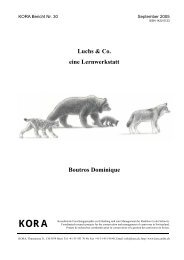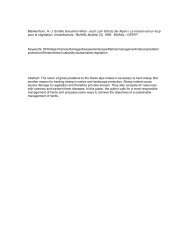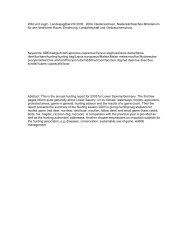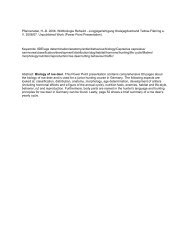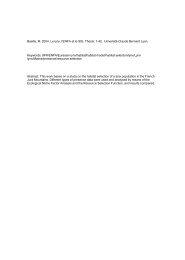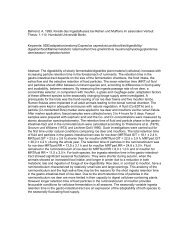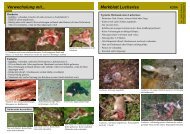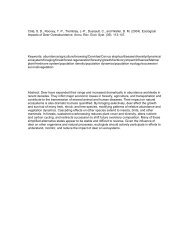You also want an ePaper? Increase the reach of your titles
YUMPU automatically turns print PDFs into web optimized ePapers that Google loves.
Juni 2002 Appendix I25Review coat patterns (supplementation of the Introduction)1. General statements on coat patterns in mammalsMammals exhibit a remarkable variety of coat patterns(Murray 1988). Especially carnivores show a wide varietyof basic pelage colors and a great diversity ofmarkings on their coat – including spots, stripes, bandsand patches (Ortolani & Caro 1996). Therefore theyare an exciting taxonomic group against which evolutionarytheories of coloration can be examined.At the turn of the century, naturalists began tospeculate about the survival value of the pelage andskin color (e.g. Roosevelt 1911). Work on animal colorationsince 1940 has concentrated primarily on thedevelopment of pelage patterning in mammals (e.g.Murray 1981), the mechanisms by which animalsmatch their background (e.g. Endler 1978) and thetheories underlying the evolution of coloration patterns(e.g. Endler 1988). It is generally accepted that specificcolor patterns in mammals are genetically determinedbut the actual mechanisms that create the patterns arestill unknown. Weigel (1961) believes that all coat patternsevolved from a dark-spotted type. The spots subsequentlybroke up and fused in a variety of ways togive the modern array of coat markings (Figure I.1).2. Present status of the research2.1. Individual identification and population estimationIn studies on the behavior of individual animals, spotpatterns have been used as the key feature to distinguishindividuals from one another in the field (Caro &Durant 1991). It is known that individual cheetahs varyin both coat color and pattern even within small populationsand tail markings of cheetahs born in the samelitter resemble each other more closely than those bornin different litters.These natural markings of coat patterns were alsoused for population estimations and studies of density.Karanth and Nichols (1998) estimated densities of wildtiger populations using photographic capture-markrecapturemodels in four ecologically distinct studysites. Based on the fact that tigers are individually identifiablefrom their stripe patterns (Schaller 1967),Karanth (1995) has demonstrated the potential for estimatingtheir population size using photographic „captures”,within the theoretical framework of formal capture-mark-recapturetheory. Tigers were identifiedfrom photographs by comparing shapes of specific individualstripes and positions of several such stripesrelative to each other on the animal body. Laass (1999)used the sight-resight method by photocaptures for aquantitative monitoring of a lynx population in thenorthwestern Swiss Alps.2.2. Developmental biology and adaptive valueSome striped animals are very difficult to detect intheir natural habitat, whilst others are clearly conspicuous.The pattern composed of regularly repeated stripeswere conspicuous and the irregular stripes were oftencryptic (Godfrey et al. 1987). The coat coloration playsan important role for the camouflage, for example alynx with a reddish coat and black spots disappears in abeech forest (Breitenmoser and Breitenmoser-Würsten1990). Coloration can yield concealment through threedifferent means: i) general color and pattern resemblanceor background invoke the similarity between ananimal’s color and that of the natural background inwhich it lives; ii) disruptive coloration, sharply contrastingcolors and irregular markings break up theform of the animal, making regions of its body appearmutually discontinuous and iii) countershading, lighteningof the ventral surface and darkening of the dorsalsurface of the animal is believed to counteract the effectsof shade and light. Striped patterns for examplemay camouflage in two ways: First, the stripes mayFigure I.1. Lynx systematics after Weigel (1961), Eurasian and Canada lynx.



